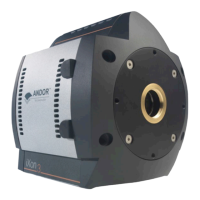Page 14
Introduction
1.3.11 - EM Gain ageing
It has been observed that some EMCCD sensors, more notably in cameras that incorporate L3Vision sensors from E2V,
are susceptible to EM gain fall-off over a period of time. It is important to note that this ageing effect applies to any
EMCCD camera manufacturer that incorporates L3Vision sensors into their cameras. In the Andor iXon3 range, this
refers to the 897, 888 & 860 models.
EMCCD cameras incorporating Impactron (EMCCD) sensors from Texas Instruments have shown rates of EMCCD
saturation-induced ageing that are orders of magnitude slower than those with E2V sensors, exposed to comparable
light intensity and gain. NOTE: 885 iXon3 models contain Impactron sensors from Texas Instruments, which do not
exhibit EM gain ageing (or at most exhibits it at a negligible level).
Atechnicalnoteentitled:“Longevity in EMCCD and ICCD”,whichfurtherexplainsthisphenomenon,canbe
downloaded from the following website: http://www.andor.com/library/publications/?app=543
If left unchecked, this ageing phenomenon has the potential to signicantly compromise the long-term quantitative
reliability of EMCCD cameras. Andor have recognized this ageing issue and have implemented innovative measures
to stabilize the EM gain on these sensors, ensuring that this ground-breaking ultra-sensitive technology can deliver a
prolonged quantitative service to the user and if these highly sensitive sensors are used with due care and attention,
ageing can be minimized and should not present any real problem to the user.
More details of this ageing effect and Andor’s solutions can be found on page 32, but listed below are some guidelines
to minimize the EM gain ageing process:
• Do not use EM gain values greater than necessary to overcome the read noise. A rule of thumb is that a gain of x4
or 5 the rms read noise (accessible from the spec sheet or performance sheet) is more than sufcient to render this
noise source negligible. In practice, this can always be achieved with EM Gain of less than x300 (often much less).
Pushing gain beyond this value would give little or no extra Signal to Noise benet and would only reduce dynamic
range
• OnlyselecttheextendedEMgainscaleofx1000forsingle photon counting applications and always ensure that
the signal falling onto the sensor is indeed within the regime of low numbers of photons per pixel.
• Turn down the gain when the camera is not acquiring
• Trynot to over-saturate the EMCCD sensor
1.3.12 - Minimizing particulate contamination
It is important that particulate contamination of the exterior of the camera window is kept to a minimum, such that
images are kept free of ‘shadowing’ particles directly in the focal path. The iXon3 range comes equipped with an internal
C-mount shutter. Whilst not being required for frame transfer operation (which is a shutter-free readout mode) it is good
practice to close the shutter when the camera is not in acquisition use for a reasonable period. It is also advisable to use
the software to close the shutter when exposing the camera to the ‘open environment’ (i.e. removed from a microscope
C-mountorfocusinglens)whilstpowerisstillowingtothecamera.
When the camera power is turned off, the C-mount shutter closes automatically and the camera can be moved freely.
We recommend that the C-mount opening is covered when the camera is not in use.
If there is evidence of particulate contamination on the front window it is possible to clean the window by blowing dry
air gently over the window surface. However, the shutter has to be kept open for this procedure, which means that the
camera has to be powered up. Therefore since light can access the EMCCD sensor during this time, we recommend that
EM Gain is turned off, (readily selectable through the software).

